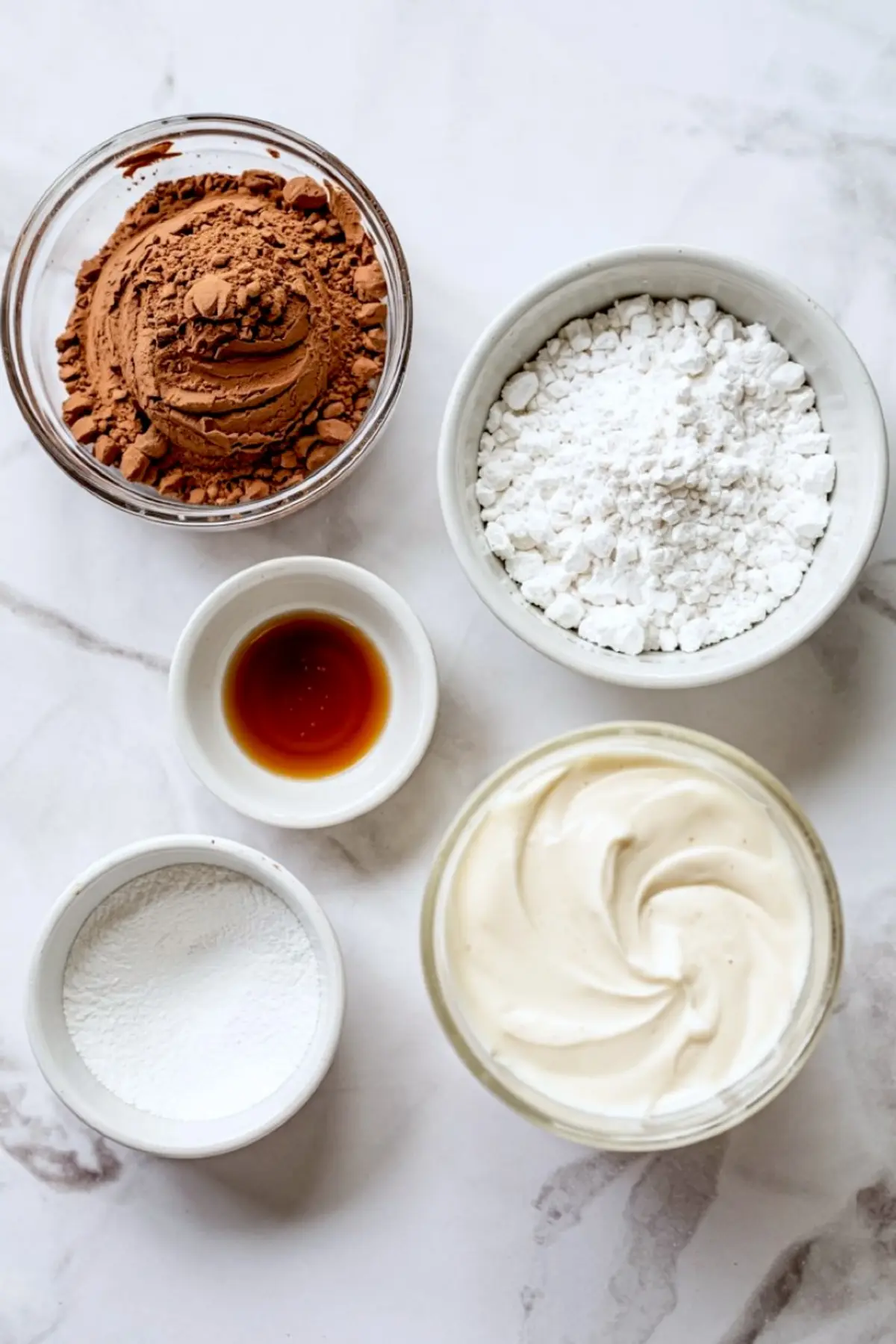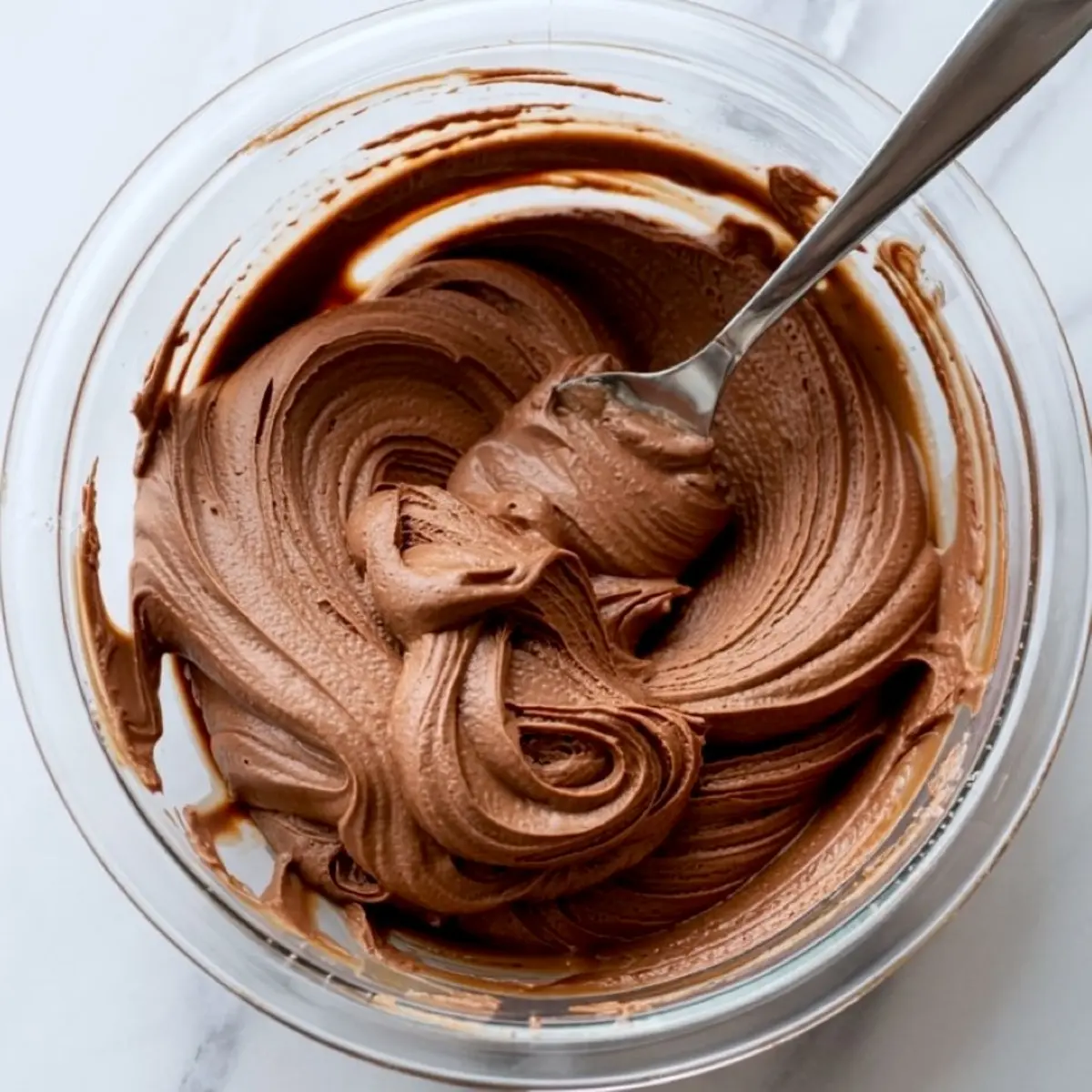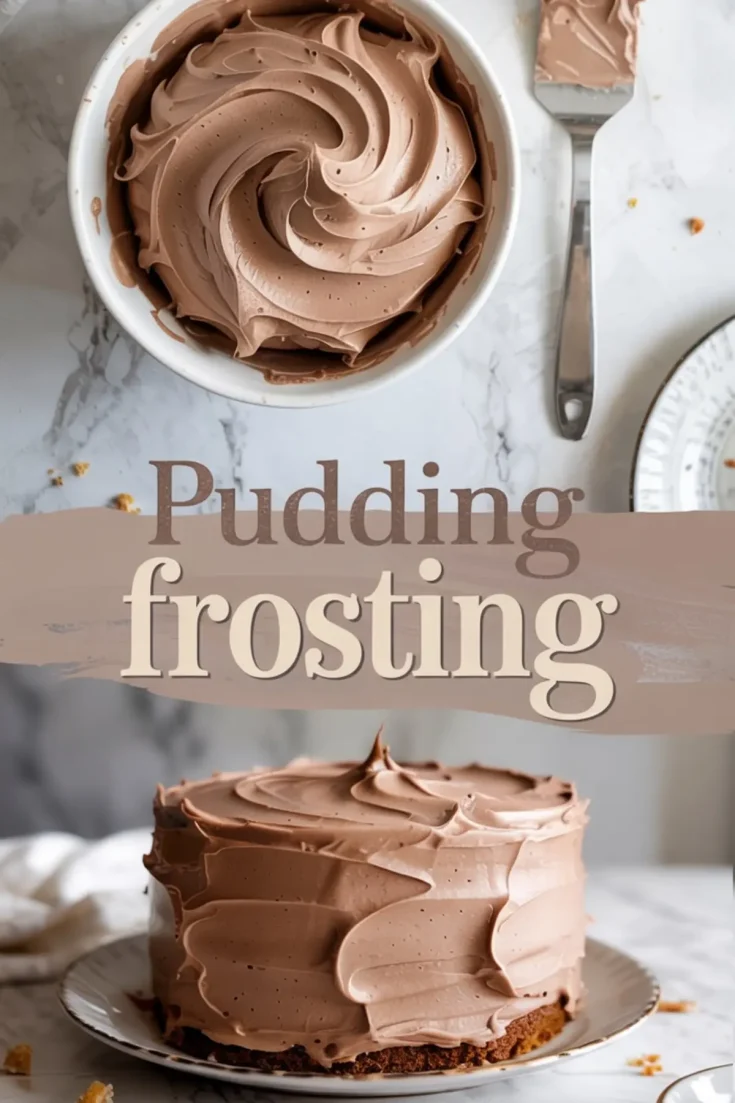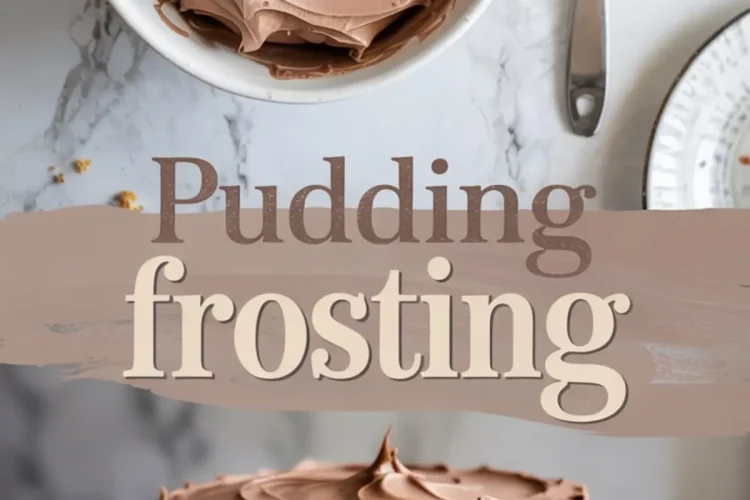Chocolate pudding frosting is one of those quick, reliable recipes you keep close at hand. You learn how to make it once, and it stays with you. You’ll find it under many names: chocolate pudding frosting, cool whip frosting, whipped icing, pudding icing, whipped pudding frosting. No matter what you call it, the result is a topping that tastes like mousse yet behaves like buttercream.
In this article, you’ll see exactly how this frosting works, why each ingredient matters, and how to use it on cakes and cupcakes without worry. You’ll also find comparisons, storage notes, and a few of my own observations from years of baking. This isn’t theory. These are lessons tested in my kitchen, and I pass them on to you.

The Instant Pudding Mix That Shapes the Frosting
The foundation is a box of instant chocolate pudding mix. It does the work of stabilizing the cream while adding flavor at the same time. I’ve tried regular cook-and-serve pudding, but it fails in this recipe. It never whips with the same texture. Instant pudding contains starches that thicken on contact with liquid, and those starches give this frosting body.

I usually reach for chocolate, though I’ve tested vanilla and pistachio on occasion. Chocolate remains the most versatile, pairing well with classics like chocolate pudding cake or even yellow sheet cake. The taste is bold, and the texture stays firm without turning heavy.
When you want something lighter in flavor, you can still explore whipped cream frosting recipes, but the pudding version has an edge in stability.
Heavy Cream, Cold and Ready

Cold heavy whipping cream turns this recipe from a shortcut into a frosting worth repeating. Cream whips to soft peaks, then stiff peaks, because the fat traps air. Once the pudding granules swell in the mixture, the cream stabilizes. You end up with something that holds shape under a piping bag yet melts gently on the tongue.
I’ve learned to chill both the bowl and beaters before I begin. Ten minutes in the freezer changes the outcome. The cream whips faster, and the frosting reaches the right texture without straining the mixer.
For comparison, I once tried this with half-and-half. It never worked. Half-and-half lacks the fat content, so the mixture separated and collapsed. Heavy cream is non-negotiable.
The Optional Sweetness of Powdered Sugar
Powdered sugar does not just sweeten. It smooths the flavor and lightens the chocolate’s sharp edge. I use it when I know the cake beneath carries less sugar, such as a plain sponge. If the cake is already sweet, I leave the sugar out. This choice lets me balance flavors across the entire dessert.
The sugar also blends without leaving grit. Granulated sugar would ruin the texture. Powdered sugar disappears into the cream and pudding mix, helping the frosting hold its soft body.
If you prefer frostings with more sweetness layered in, try maple frosting. It brings a depth that powdered sugar alone cannot provide.
Vanilla Extract as a Flavor Anchor
Vanilla may seem small, yet it adds balance. It rounds out the chocolate and stops it from feeling one-note. I’ve made this frosting without vanilla and found the taste sharper, more artificial. With vanilla, the finish becomes mellow.
It is optional, but if you already have good vanilla extract in the cupboard, add it. I use one teaspoon, sometimes less. Think of it as a background note in a piece of music. You notice its absence more than its presence.
Mixing and Stopping at the Right Time

The steps look simple: chill the tools, combine the dry mix, add cream, whip, then stop. The detail lies in knowing when to stop. Overbeating leads to curdling. Underbeating leaves you with soup.
I usually beat on low speed to start, then turn the mixer up high. Two to four minutes later, stiff peaks appear. Once they do, I stop. It feels abrupt, but it is necessary. Frosting holds its shape better this way.
For chocolate lovers, this method produces a result that competes with chocolate buttercream frosting. The difference is speed and texture. Buttercream is rich, heavy, and longer to prepare. Pudding frosting is quick, airy, and mousse-like.
Serving Notes from My Kitchen
I’ve used this frosting on cupcakes, loaf cakes, and even cookies. It spreads smoothly with a spatula, but it also pipes well for borders and swirls. On a chocolate pudding cake, the flavor blends seamlessly with the base. On vanilla cake, it creates contrast that feels more striking.
One trick I keep in my notebook: chill the decorated cake for ten minutes before serving. The frosting firms just enough to hold shape when sliced. It keeps the presentation neat without losing softness.
Storing and Timing the Use
Pudding frosting stays at its best when fresh. The cream remains thick and stable for two hours at room temperature. After that, I recommend refrigeration. It holds for a short while in the fridge but loses some lift if stored too long. Freezing is not an option.
When I need something with longer staying power, I sometimes switch to cool whip cream cheese frosting. That combination survives refrigeration better. Still, for quick serving or day-of use, pudding frosting is the winner.
My Practical Comparison: Pudding Frosting vs Whipped Cream Frosting
I’ve tried both side by side. Pudding frosting delivers structure. It stands tall, pipes cleanly, and resists sliding. Whipped cream frosting, on the other hand, feels lighter, more delicate, but collapses faster.
If you need decoration that holds through a party, choose pudding frosting. If you prefer a softer topping for fruit or lighter cakes, whipped cream frosting remains a good choice. I use both in different settings, but I return to pudding frosting more often because it feels dependable.
Share, Save, and Bake Again

Chocolate pudding frosting proves that easy recipes can still deliver quality. You learn it once, then repeat it for birthdays, quick weeknight desserts, or weekend projects. It bridges the gap between whipped pudding frosting and traditional icing styles, giving you flexibility without fuss.
If you plan to make it soon, save this recipe to Pinterest so you can return to it later. And if you try it, share in the comments how it turned out or what cake you paired it with. Your experience may help another baker.
Pudding Frosting Recipe

Chocolate pudding frosting blends instant pudding mix with cold heavy cream to make a smooth, whipped topping that holds its shape and sets in minutes. I use one box of chocolate pudding, whip it with cream, and sometimes add powdered sugar or vanilla for a little extra sweetness. It’s a frosting made from instant pudding that feels rich like mousse but pipes like buttercream. You can use this on cupcakes, sheet cakes, or chocolate pudding cake for a soft, creamy finish. This pudding frosting recipe cool whip fans will love—no butter, no mixer drama, and totally reliable. Keep it in your rotation of frosting recipes easy enough for weeknights or when you want pudding and whipped cream frosting that’s ready fast.
Ingredients
- 1 box (3.9 oz) instant chocolate pudding mix
- 2 cups heavy whipping cream (very cold)
- ½ cup powdered sugar (optional, for added sweetness)
- 1 teaspoon vanilla extract (optional)
Instructions
- CHILL EQUIPMENT: Place your mixing bowl and beaters in the freezer for 10–15 minutes. Cold tools help the cream whip more efficiently.
- COMBINE DRY INGREDIENTS: Add the chocolate pudding mix, powdered sugar (if using), and vanilla extract to the chilled mixing bowl.
- ADD CREAM: Pour in the cold heavy whipping cream.
- WHIP FROSTING: Begin mixing on low speed to incorporate the ingredients, then increase to high speed and beat until stiff peaks form, about 2–4 minutes depending on your mixer.
- STOP AT STIFF PEAKS: Once the frosting becomes thick and fluffy, stop mixing. Avoid overbeating, as this can cause the mixture to curdle.
- USE OR CHILL: Use the frosting immediately to decorate cakes, cupcakes, or cookies. Alternatively, refrigerate for up to 2 hours before using.
Notes
Keep the cream very cold for best results. The frosting is most stable when used immediately after whipping but can be stored in the refrigerator for short periods. Do not attempt to freeze.
Nutrition Information
Yield
1Serving Size
1Amount Per Serving Calories 2219Total Fat 174gSaturated Fat 110gTrans Fat 6gUnsaturated Fat 52gCholesterol 538mgSodium 1883mgCarbohydrates 155gFiber 4gSugar 135gProtein 16g

